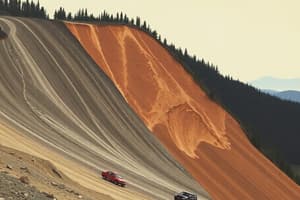Podcast
Questions and Answers
What is the angle of repose in the context of mass wasting?
What is the angle of repose in the context of mass wasting?
- The maximum height a mountain can reach without collapsing.
- The angle at which water will flow downhill.
- The steepest angle a hillside can maintain before sediments begin to move. (correct)
- The temperature at which materials begin to melt.
Which of the following is the fastest type of mass-wasting event?
Which of the following is the fastest type of mass-wasting event?
- Creep
- Fall (correct)
- Flow
- Slide
What are talus slopes typically composed of?
What are talus slopes typically composed of?
- Vegetation and organic matter.
- Water and soil layers.
- Clay and silt deposits.
- Sediments accumulated at the base of a hill or mountain. (correct)
What is a lahar?
What is a lahar?
Which mass-wasting event is characterized as occurring at a slow rate?
Which mass-wasting event is characterized as occurring at a slow rate?
What causes a mass-wasting event to occur when a slope becomes steeper than the angle of repose?
What causes a mass-wasting event to occur when a slope becomes steeper than the angle of repose?
What is the term used for steep cliffs left behind after a mass-wasting event?
What is the term used for steep cliffs left behind after a mass-wasting event?
Which of the following can NOT trigger a mass-wasting event?
Which of the following can NOT trigger a mass-wasting event?
Flashcards
Mass wasting
Mass wasting
The downward movement of rock, soil, and other materials due to gravity.
Angle of repose
Angle of repose
The maximum steepness a slope can withstand before gravity causes material to move downward.
Fall
Fall
The fastest type of mass wasting event where material falls freely.
Slide or flow
Slide or flow
Signup and view all the flashcards
Creep
Creep
Signup and view all the flashcards
Avalanche
Avalanche
Signup and view all the flashcards
Lahar
Lahar
Signup and view all the flashcards
Talus slope
Talus slope
Signup and view all the flashcards
Study Notes
Mass Wasting
- Mass wasting is the action of gravity as a geomorphic agent
- Common terms for mass wasting events are landslides, but this is not a technical term
- Mass wasting can be triggered by various events like heavy rain, snowmelt, earthquakes, and forest fires, but not always a large event
- Maximum steepness of the hillside/mountain is called angle of repose. When hillside/mountainside steepness exceeds angle of repose, gravity moves regolith downward until angle of repose is restored
- Different types of mass wasting events exist, including falls, slides, flows, and creeps
- A fall is the fastest type, followed by slides and flows
- Creep is the slowest type, can be glacier-related (solifluction)
- Mass wasting events can involve various materials like rock, debris, earth, or mud
- Avalanche can be rock, mud, or a glacier-related snow avalanche
- Accumulation of sediment from mass wasting events can create talus slopes or escarpments - steep cliffs at the base of a slope
Studying That Suits You
Use AI to generate personalized quizzes and flashcards to suit your learning preferences.




